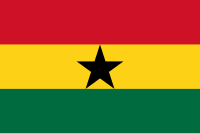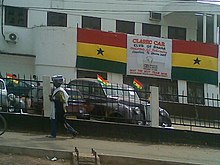Flag of Ghana
| Flag of Ghana | |
|---|---|
 |
|
| Vexillological symbol : |
|
| Aspect ratio: | 2: 3 |
| Officially accepted: | March 6, 1957, restored on February 28, 1966. |
The model of the flag of Ghana was the flag of Ethiopia , whose color sequence was reversed. Ghana became the first colony in Africa to become independent after World War II and its first President Dr. Kwame Nkrumah a leading figure in Pan-Africanism , the idea of a politically united Africa. Many other African states that later became independent took this flag as a model and chose the same colors to express the pan-African idea. The flag was designed by Ghanaian Theodosia Salome Okoh in response to a call in her local newspaper . The announcement said: "The flag should be original and contain motifs that many residents of the country can identify with."
Description and meaning
The national flag consists of three horizontal stripes in the pan-African colors of red-yellow-green. The yellow stripe has a black star in the center. Okoh explained her choice of colors as follows: “With regard to the geography of Ghana, I chose the three colors red, gold and green. Ghana is located in the tropics and is blessed with rich vegetation. The color gold refers to the wealth of natural resources and red commemorates those who worked or died for the country's independence. And the five-pointed star is the symbol of African emancipation and unity in the fight against colonialism. "
According to the official description, red is a reminder of the blood that was shed in the struggle for freedom, yellow symbolizes the country's wealth (the name of the former colony “ Gold Coast ” already indicated this) and green stands for the country's forests and fields. The black five-pointed star in the center of the flag is considered the guiding star of African freedom. It is often misrepresented: the star should touch the top and bottom stripes.
Bolivia uses the same tricolor without a star and with a different aspect ratio than its national flag .
History of the national flag
Between 1877 and 1957 the British colony of the Gold Coast , the forerunner of today's Ghana, used a typical British colonial flag: dark blue with the Union Jack in the canton (top left corner) and the colony's emblem at the bottom right. The east of what is now Ghana was part of the German colony of Togoland until 1914 . For Togoland there was a proposal in 1914 for the colony's own flag. However, it was never introduced due to the First World War .
On March 6, 1957, the flag that is still used today was introduced with independence.
Ghana's flag was the template for the Ghana-Guinea-Union ( Union of African States ) from November 28, 1958. It differed from the Ghanaian flag only in that it contained two stars. After Mali joined the Union in April 1961, a third star was added, and the number of stars should be increased accordingly for further accession (which never happened). The project ended in 1962.
On January 1, 1964, the yellow stripe was replaced by a white one, based on the party flag of the ruling Convention People's Party . For some time both flags were used side by side. After the fall of the government of Dr. Kwame Nkrumah was reintroduced the old flag from 1957 on February 28, 1966.
Flags of the ethnic groups
More flags of Ghana
2: 3 ? Trade flag

2: 3 ? Navy flag ( naval war flag )

swell
Main sources
- Whitney Smith , Ottfried Neubecker : The signs of people and peoples. Our world in flags and banners. Reich Verlag, Lucerne 1975, ISBN 3-7243-0115-4 .
- Flags of the World - Ghana (English)
Individual evidence
- ^ A b Whitney Smith, Ottfried Neubecker: Coats of arms and flags of all nations. Battenberg, Munich 1980, ISBN 3-87045-183-1 .
- ↑ Flags of the World - Colonial Flags 1914 (Germany)













